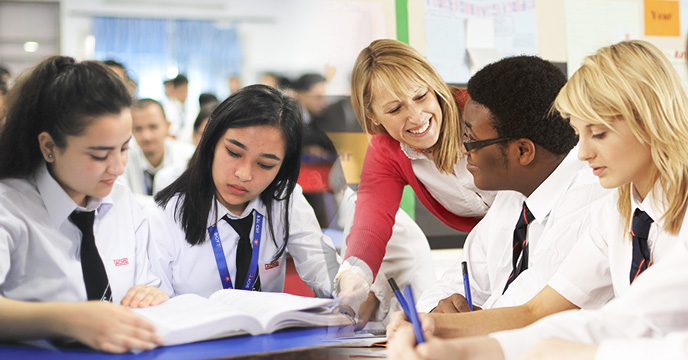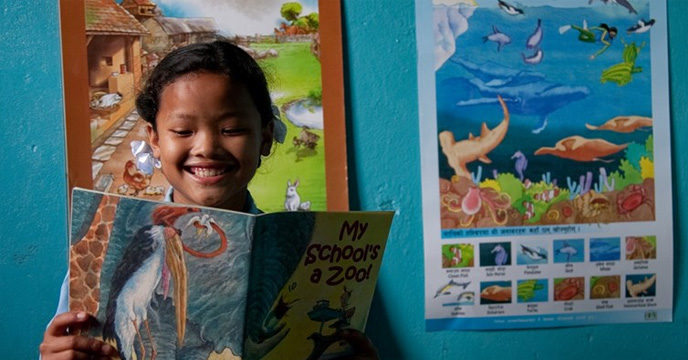The post Nepal Education System – An Overview of Challenges and Opportunities appeared first on Nepali Sansar.
]]>The scenario in Nepal is such that Nepalis with a foreign degree are preferred over a Nepali student with a national degree.
This throws light on the existing curriculum and teaching methodology in the country. An overview of the past few generations knowledge gaining shows that the younger has not learned anything new than the older generations.
The Nepali education system has failed to provide the same educational standards that the global industry demands.
The current knowledge trend in Nepal is such that students are pursuing degrees not for the sake of knowledge gaining but for the sake of earning an undergraduate certification.

This in turn is creating a generation of individuals lacking self-confidence. Their lack of satisfaction in the jobs they take up in line with their stream of education is resulting in a lot of educated unemployment in Nepal.
While this trend is on the rise, Nepali employers are finding it equally difficult to find qualitative candidates who own problem solving and critical thinking skills.
Nepal Vs International Education System

Looking at what foreign universities have to offer, courses in foreign countries are research based, training students to be problem solvers. Research propels knowledge gaining and problem solving. The credit for such courses and curriculum goes to experts who design them after a lot of research and insight into the future and the current job industry requirements.
With this research-based approach, students who study at a foreign university are motivated to look for two or more references, enabling them to come up with unique documentation, supported with substantial proof.
On the other hand, the curriculum in Nepal doesn’t promote research and most of the knowledge gaining is done through model papers, referring to old Q&As and other learning material. Nepali students who produce material based on research are given lower grades in Nepal, when compared to their valuation in international universities.

However, this scenario is slowly changing and there is a steady rise of Nepali education institutions affiliated with foreign universities. The demand for students studying in such universities is very high as they are in a position to compete nationally and internationally.
International degrees challenge the intellect of students by getting them to work on a particular project or work area and gain a hands-on experience well in advance.
Even if students fail to secure higher grades, they at least have the knowledge, confidence and skill to tackle and manage complex situations at the work front.
Factors Challenging Nepal’s Education System

The following factors pose a challenge to Nepal’s education system:
1) Political Instability and bureaucracy
Nepal has witnessed a series of political upheavals in the last three decades. This has impacted the education system and has held it back from working independently.
Government support and the freedom for the education system to make critical decisions pertaining to the sector can majorly uplift the education system in Nepal.
2) Lack of Practical learning approach
Although the curriculum of Nepal is not completely backward, it lacks a practical approach to learning, where students are motivated to research, create and learn from their own experience.
Additionally, the education system is not strict with plagiarism and encourages students to rely and study only from limited material. Students in Nepal should be made to conduct research, gain hand-on experience and be given the choice to make their own decisions.
3) Job-driven knowledge gaining
Many Nepali graduates are educating themselves only to get jobs. Instead, the education system in Nepal should encourage students to develop entrepreneurial skills and critical thinking skills and enable to become free thinkers.
Nepal’s education system should enable students to develop entrepreneurial skills and others to help them become more proactive in self-growth and national building in the larger picture.
4) Nepalis Permanently Settling Abroad
The situation in Nepal is such that the society is divided into well-to do students whose families are financially sound and they go to foreign countries only to study a particular course and come back to run family businesses. However, this is a smaller majority.
On the other hand, there are a number of students who go abroad to seek permanent residence and then take up jobs in those destinations to payback their loans.
Students should come back to Nepal to help support the development of the nation. Foreign destinations are highly developed due to the knowledge and skill individuals receive in their respective nations’ educational institutions. These skills in return are utilized in the development of their countries.
Conclusion
It’s high time that Nepal considered a review of its curriculum and teaching methodologies. Only then will it be at par with the international education standards and provide a generation of capable, self-confident and knowledgeable individuals.
For more Nepal education news, visit NepaliSansar’s Education page.
Related Articles:-
- Nepal Medical Education Commission Increases Scholarship Quota by 65 Percent
- The World University Rankings 2020: Nepal’s TU Enters Top World Universities
- Nepal Education Loan – Eligibility & Documents for Student Loan
The post Nepal Education System – An Overview of Challenges and Opportunities appeared first on Nepali Sansar.
]]>The post Management Courses on Demand in Nepal, Human Resources Lacking appeared first on Nepali Sansar.
]]>Because of the boom in banking and other related sectors, majority of Nepali students are shifting their focus towards management courses away from regular educational courses.
According to Nepal UGC, management courses comprise of around 1.5 lakh applications out of the total 3.6 lakh enrolments at the university level in the country.
Master’s in Business Studies and MBA are among the top career preferences at the master’s level, currently.
Although renowned varsities like Tribhuvan University had courses like M.Com since 1960s, MBA degree courses that came later somewhere in around 1993 are gaining more attention.
Kathmandu University introduced MBA degree course in 1993, following which, demand for the course increased pushing many other colleges to introduce in their curriculum.
And, many investors have been keen about offering such courses in affiliation with foreign universities, along with local universities.
While there are around 37 colleges in total offering the MBA degree, 16 stand affiliated to foreign universities in USA, UK, India and Malaysia.
Human Resource, A Serious Concern
College managers argue that the increasing inclination among students towards MBA degree is encouraging, but proper availability of human resource is compulsory to ensure quality education.
According to them, colleges should be granted licenses based on their human resource availability.
“One should be very clear, along with knowledge a MBA student must have problem-solving skill once s/he graduates. I regret to say not all colleges fulfil this standard,” says Tribhuvan University Management Dean Dilli Ram Sharma.
Sharma, based on his inspection, says that many colleges lack full-time faculty making it difficult for after-class consultation. “This does not mean there aren’t excellent colleges here. Many colleges are truly doing well,” adds Sharma.
Another major issue is the enrolment of fresher/inexperienced students for the course and lack of internship programs for students.
Meanwhile, South Asian Institute of Management Principal Ashok Raj Pandey feels that the entire education system in Nepal is currently examination-focused.
While MBA students pursue hundreds of cases during their course in universities like Harvard, MBA students in Nepal complete their course without studying at least some dozen courses, resulting in degree lacking required skill-set.
Lack of Academia-Industry Collaboration
This is another serious problem in Nepali education structure.
College managements report that the academia has failed to establish proper linking with the country’s leading industry bodies such as Federation of Nepali Chambers of Commerce and Industry (FNCCI), Confederation of Nepali Industries (CNI) and Nepal Chamber of Commerce (NCC), among others.
“The production of graduates should be based on the need of the market, but we have failed to internalize this crucial fact,” admits Pankaj Jalan, Chairman of Lord Buddha Education Foundation.
So, the government has to approve academic institutions based on their human resource requirements.
Following recommendations from various institutions, the Ministry of Education has already formed a panel in coordination with the National Planning Commission (NPC) to fill human resource gaps in various sectors, Jalan informed.
The panel is currently studying various aspects of the matter and is expected to come up with the number of human resource requirements that the country needs in different fields over the next 25 years.
Factors to be analyzed part of the study include current situation of human resources, number of graduates in different sectors and employment prospects, among others.
Hope the study will fill the gaps in the country’s education sector and pave ways for quality education and sufficient opportunities.
The post Management Courses on Demand in Nepal, Human Resources Lacking appeared first on Nepali Sansar.
]]>The post Japan Pledges Rs 308 Mn Aid to Nepal Education Sector appeared first on Nepali Sansar.
]]>In a recent update, Japan agreed to extend a grant worth Rs 308 million to Nepal’s seven-year SSDP under the Ministry of Education, Science and Technology.
Officials on behalf of the Governments of Nepal and Japan exchanged MoUs in this regard as part of a meeting at the Ministry of Finance in Kathmandu on October 05, 2018.
SSDP, a continuation to the Nepali Ministry of Education’s School Sector Reform Program (SSRP), aims to enhance the equitable access, quality and efficiency of basic & secondary education in Nepal.
Teaching & learning methodology, student training, more effective education system, sectoral planning & management and governance are among keys of focus for the program.
The program will be implemented in a more harmonized and coordinated approach through a joint financing agreement under a sector-wise approach involving other development partners.
This is a seven-year program started in FY 2016-17.
Also Read:
The post Japan Pledges Rs 308 Mn Aid to Nepal Education Sector appeared first on Nepali Sansar.
]]>The post Education Ministry Tops Nepal’s Complaint List in FY’18 appeared first on Nepali Sansar.
]]>According to the Nepali Commission for Investigation of Abuse of Authority (CIAA), Education Ministry alone accounted for 18 percent of the total complaints (3,570) registered in the last fiscal.
The anti-graft body found around 3,570 complaints to have registered against the Education Ministry, while Federal Affairs Ministry (3,511) in the second and Land Reforms Ministry in the third position with 1,262 complaints, followed by Forest and Soil Preservation Ministry, Health, Home Affairs, Physical Infrastructure and Finance Ministries.
Surprisingly, these three ministries topped the anti-grant body’s complaint list even in the
2016-17 fiscal.
“We do not know the exact reasons why complaints on irregularities in the ministries of education, federal affairs and lands reforms remain the highest. It could probably be because offices of these ministries have penetrated across the country and they are easily accessible to people,” says Rameshwor Dangal CIAA Spokesperson.
Fake certifications of school teachers, irregularities in construction of basic amenities in schools were among the key complaints registered under the Education Ministry, CIAA adds.
CIAA cleared 12,400 out of the total number of complaints and filtered out only 6,458 complaints for further investigation and stopped action against 262 complaints. Whereas, the last fiscal saw detailed investigations against 546 complaints.
Complaints Registered Against Various Nepali Ministries at CIAA (for FY 2017-18):
| Ministries |
Total No. of Complaints |
|
Education |
3,570 |
|
Federal Affairs |
3,511 |
|
Land Reforms |
1,262 |
|
Forest |
874 |
|
Health |
851 |
|
Home Affairs |
804 |
| Physical Infra |
550 |
| Finance |
504 |
|
Others |
7,562 |
|
Total |
19,488 |
The post Education Ministry Tops Nepal’s Complaint List in FY’18 appeared first on Nepali Sansar.
]]>The post 52nd International Literature Day 2018 – A Look at Events, Initiatives in Nepal appeared first on Nepali Sansar.
]]>It has been noted that despite progress in literacy statistics, challenges still persist and conditions have become even more critical, going by the growing demand for ever-evolving skills.
In 2018, through the International Literacy Day UNESCO aims to explore and highlight integrated approaches that can simultaneously propel the development of literacy and skills required to:
- Ultimately improve people’s life and work
- Contribute to equitable and sustainable societies
Let’s take a look at how the governing body has tried to bring about this change in Nepal.
Nepal celebrated the two events with the theme ‘Skilled Human Resources Development and Sustainable Educational Infrastructure – the Basis of Building Socialism-oriented Prosperous Nation’.
In view of the upcoming day and with the goal to foster the theme of ILD 2018, the UNESCO Kathmandu Office scheduled the following initiatives throughout the month of September:
- Launched a five-day training for school drop-outs including women and adolescent girls on vegetable production with an aim to provide them a livelihood & supplement their family income
- Launched a 26-day Digital Literacy Skills training for students of open schools, women schools, farmers schools and young girls & women from Pharping community
- A folk duet song Lok Dohori in Nepali language on the occasion of the International Literacy Day to make participants (general public) realize the significance of literacy and lifelong learning
- Launched a 45-day beautician training program for neo-literate women in Ratna Nagar Municipality to promote sustainable livelihood opportunities
- Orientation program for local-level officials on non-formal education (NFE) implemented by Nepal Eastern Region Education
Nepal Government, on its own, is also working hard to improve literacy in Nepal. Nepal’s Education Ministry will also be conducting some activities in the interest of the people, on the occasion of the 39th Nepal Education Day.
International Literacy Day Activities in Nepal Include:
- Cleanliness and Tree Plantation Program in Bhaktapur on the occasion of Nepal National Education Day; celebrated on September 8, 2018 every year
- Dialogue on Literacy telecasted on Nepal Television and Radio Nepal
- Street Drama on Literacy and Lifelong learning
- Consultation Workshop on the Non-formal Education Equivalency at Kathmandu
- Nepali Folk Duet (Lok Dohori) on Literacy and Non-formal Education
- Publication of a Special Edition in Nepali language on the 39th NED and 52nd ILD in Gorkhapatra National Daily
- Main Celebration Event and Exhibition to observe the 39th NED and 52nd ILD organized by Nepal Education Ministry. The event was chaired by Hon. Nepal Education Minister Giriraj Mani Pokharel and witnessed the participation of Nepal Government officials, development partners, students, teachers and other stakeholders
- A Journal on Literacy and Lifelong Learning was also launched and a video documentary on NFE and literacy-related activities in Nepal, produced by Nepal Centre for Education & Human Resource Development
Additional activities included:
- Launch of the Functional Literacy Program in Mahottari, Parsa, Rautahat and Sarlahi which was organized by Aasaman Nepal
- Literacy Awareness Rally in Chitwan and Janakpur, Tree Plantation Program in Banke and Street Drama on theme related to Literacy and Lifelong Learning in Kathmandu organized by Samunnat Nepal
Recent statistics show some major progress in Nepal’s literacy rate, both in men and women.
Let’s take a look at some of them:
- The overall literacy rate of Nepal stands at 75.14% in Nepali men compared to 57.59% in Nepali women
- Province-wise literacy statistics:
- Province 1 overall literacy stands at 79.27 percent in men and 63.94 percent in women.
- Province 2 depicts a 60.09 percent literacy rate in men and 38.88 percent in women.
- Province 3 shows an 82.82 percent literacy rate in men and 67.04 percent in women.
- Gandaki Province records an 83.4 percent literacy rate in men and 67.42 percent in women.
- Province 5 presents a literacy rate of 75.50 percent in men and 58.33 percent in women.
- Karnali Province reports a literacy rate of 72.88 percent and 53.21 percent in women.
- Province 7 reports a 76.37 percent in men and 51.93 percent in women.
- Kathmandu Metropolitan City, Butwal Sub-Metropolitan City, Kirtipur Municipality, Tokha Municipality and Lalitpur Metropolitan City show impressive literacy rates, far better than the overall literacy rate of Nepal
- Two municipalities of Province 6, one municipality of Province 2, one municipality of Karnali Province and one municipality from Province 5 fall far below the overall national literacy rate of 65.9%
- Currently, the primary school enrollment rate has reached 97.2 percent
The main program saw the distribution of prizes to various outstanding schools, educationalists and university graduates – who also received the Bidhyabhusan medals for topping various examinations under different faculties, by Nepal Education, Science & Technology Minister.
The Education Ministry launched the ‘Policy and Program on Reforming the Educational Quality in Community Schools, 2018’ on September 8, 2018.
UNESCO Declares International Literacy Day:
UNESCO declared International Literacy Day on October 26, 1966 with the aim to highlight the importance of literacy to individuals, communities and societies, across the world.
- According to UNESCO statistics, over 775 million adults lack minimum literacy skills; one in five of them are still not literate and two-thirds of the total number are women
- 7 million children are out of school and many more continue to attend school irregularly or drop out
- As per UNESCO’s ‘Global Monitoring Report on Education for All (2006), South Asia has the lowest regional adult literacy rate which stands at 58.6 percent
Conclusion:
The world countries may have achieved or are heading to their goal of achieving increased literacy rates. But with Nepal, the progress is constantly on, monitored and supported to bring about the desired results. And, with the government and people’s collective efforts, the country will soon be able to stand among countries with high literacy rates.
The post 52nd International Literature Day 2018 – A Look at Events, Initiatives in Nepal appeared first on Nepali Sansar.
]]>